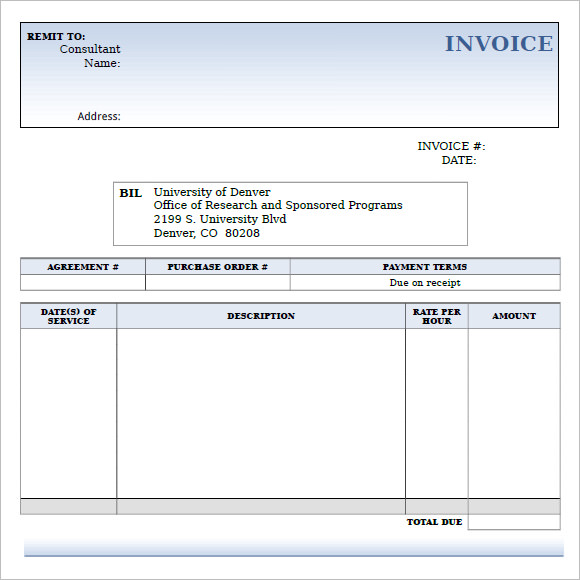

Macro - A batch of computer instructions that execute when a given command is executed. For example, the first tab located in the IPS form is titled 0.1_ODOT. Each tab contains the name of the worksheet it contains, and, when clicked, will open to the selected worksheet.
CONSULTING SAMPLE INVOICE SERIES
Tab - A series of worksheet labels located at the bottom of an Excel workbook. Also called a "spreadsheet." A worksheet consists of cells that are organized into columns and rows, and a worksheet is always stored in a workbook. Worksheet (sheet) - The primary document that you use in Excel to store and work with data. A workbook contains worksheets of rows and columns in which you can enter and calculate data. Workbook - A spreadsheet program file that you create in Excel. NOTE 11.1: For the purposes of the IPS form, Rate of Pay and Unit of Work compensation are treated the same.Ģ For a complete listing of all applicable definitions and other policies and procedures, refer to the Specifications for Consulting Services, 2010 Edition.ģ The Average Overhead Rate for Net Fee Calculation is available online. Unit of Work - A type of remuneration that establishes a specific unit amount payable for each unit of Services performed. Lump Sum - A type of remuneration for a specific total amount payable (sum certain) for the performance of the Service.

Rate of Pay - A type of remuneration that establishes a specific rate of pay in the Agreement applicable for each classification of employee, including Principals, for the time the Consultant directly utilizes each individual in the performance of the Agreement. Net Fee (in dollars) = (A + A* B) * C or A* (100% + B) * Cī Average Overhead Rate for Net Fee Calculation (percentage)3
CONSULTING SAMPLE INVOICE PLUS
Methods of CompensationĪctual Costs Plus a Net Fee (Cost Plus) - A type of remuneration that is a combination of the Consultant's actual allowable costs and a net fee as set forth in the Agreement.Īctual Cost - A type of remuneration that is a combination of the Consultant's actual allowable costs and a net fee based on the following formula:


Common NSDCs include subconsultant costs, travel costs (e.g., vehicle mileage, airfare, meals/per diems, parking, tolls, and lodging), supplies, and materials.Īdditional definitions are available in the Uniform Audit & Accounting Guide, 2010 Edition, and ODOT's Contract Audit Circulars. Non-Salary Direct Costs (NSDCs) - Other direct costs incurred by the Consultant in the performance of the Agreement. Like overhead, cost of money is represented as a rate and generally is applied as a percentage of direct labor cost. Overhead is represented as a rate and generally is applied as a percentage of direct labor cost.Ĭost of Money (Facilities Capital Cost of Money) - An imputed cost determined by applying a charge rate to the facilities capital employed in performance of the Agreement. Overhead - Indirect costs incurred by the Consultant that cannot be traced to an intermediate or final cost objective (project). Direct (direct labor and non-salary direct costs) and indirect (overhead and cost of money) costs billed against actual cost Agreements must exclude all unallowable costs.ĭirect Labor - Labor costs incurred in the performance of the Agreement based on actual hours worked at an employee's actual rate of pay. These limitations are based on the Cost Principles found in FAR Subpart 31.2 and may include additional requirements as mandated by State law. Definitions a. Reimbursement Terminology 1Īctual Allowable Costs - Costs reimbursed under actual cost Agreements, which are limited to specified criteria described in the Agreement. For example, "billing period" and "invoice period" are analogous. Conversely, the term "Task Order" is used when there are tasks on the project (the project may have multiple encumbrances and PIDs).įor the purposes of this guide, the terms "invoice" and "billing" are synonymous and interchangeable. When the term "PDP" is used, this typically means there are no tasks on the project. The IPS is designed to accommodate different project types but is primarily focused on PDP (Project Development Process) projects and Task Order Agreements. The IPS is designed for use on new projects that have not been invoiced however, with written permission from ODOT, consultants may use the IPS on current projects for which invoicing has already occurred (see instructions in section XIII). The new IPS must be used by prime consultants, subconsultants, and Local Public Agencies (LPAs). In 2010, The Ohio Department of Transportation (ODOT) worked in conjunction with the American Council of Engineering Companies (ACEC) to develop a revised Invoice and Project Schedule (IPS) form.


 0 kommentar(er)
0 kommentar(er)
